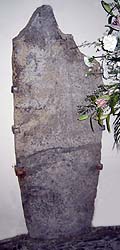
EBK Home
Kingdoms
Royalty
Saints
Pedigrees
Archaeology
King Arthur
Adversaries
For Kids
Mail David
 Saxon
Steyning
Saxon
Steyning& the Church of St. Cuthman
According to the Domesday Book, in 1066, there were 118 noteworthy houses in Steyning and, twenty years later, there were 123. The population might be estimated at about 600 people. It must, therefore, have been a small market town in the preceding Saxon period and a recent series of excavations have made it among the best understood settlements of this type. The place seems to have grown up around a minster church (the present building is mostly 12th century), which had been made famous by the acquisition of the relics of St Cuthman. Its close proximity to the navigable River Adur made it an ideal spot for trading activities and, by the late Saxon period, it was actually known as the 'Port of St. Cuthman'. Coins of King Edgar and Continental imports of Beauvais or Pingsdorf ware pottery have been found throughout the town, as well as a late Saxon pewter disc brooch of a type usually associated with urban markets. By the mid-9th century, the minster had become favoured by Royalty and may have been considered the Royal Church of the sub-Kingdom of Sussex. King Aethelwulf, father of Alfred the Great, was buried here in AD 858 and his supposed grave-cover can still be seen in the church. Although his body was later removed to the Old Minster in Winchester.
 North-East
of the present church, excavation has revealed part of a large enclosed
settlement occupied between, at least, the 10th and 11th centuries. There
was a gateway of a late Saxon type, comparable with those found at Little
Paxton (Cambs) and Cheddar (Som), leading to two post-built timber
buildings, like those often associated with more rural settlements.
Rubbish pits were dug nearby. Pottery, used within the buildings, was
mostly of local manufacture, but the occupants may have been of a
reasonably high-status, as indicated by the discovery of a late 9th
century inscribed gold ring. Unlike larger Saxon towns, there was little
sign of any formal planning and the place seems to have been made up of
loose groups of enclosed farmsteads. The density of occupation across the
whole town seems to have been somewhat low and, though industries such as
iron working were in evidence, production seems to have been mostly
agricultural in nature. Soil analysis has produced evidence for wheat,
barley, flax, oats, beans and vetch, as well as wild fruits, being
consumed and, perhaps, sold in Steyning.
North-East
of the present church, excavation has revealed part of a large enclosed
settlement occupied between, at least, the 10th and 11th centuries. There
was a gateway of a late Saxon type, comparable with those found at Little
Paxton (Cambs) and Cheddar (Som), leading to two post-built timber
buildings, like those often associated with more rural settlements.
Rubbish pits were dug nearby. Pottery, used within the buildings, was
mostly of local manufacture, but the occupants may have been of a
reasonably high-status, as indicated by the discovery of a late 9th
century inscribed gold ring. Unlike larger Saxon towns, there was little
sign of any formal planning and the place seems to have been made up of
loose groups of enclosed farmsteads. The density of occupation across the
whole town seems to have been somewhat low and, though industries such as
iron working were in evidence, production seems to have been mostly
agricultural in nature. Soil analysis has produced evidence for wheat,
barley, flax, oats, beans and vetch, as well as wild fruits, being
consumed and, perhaps, sold in Steyning.
